Equipment for Experimental Protocols
Our experimental protocols utilize many different types of equipment and methods to complete each study. All research is performed in the General Clinical Research Center at the University of Maryland Medical Center. We briefly introduce some of the techniques and methods of measuring responses and monitoring our volunteers in the following sections.
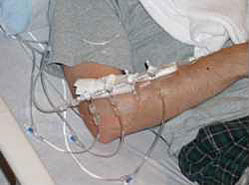
Glucose Clamps
During glucose clamps, insulin is infused in research volunteers at physiologic dosages which causes suppression of insulin release by the body. Glucose enters cells and can stimulate glucose counter-regulatory mechanisms if blood sugar is allowed to decrease. A dextrose solution is variably infused to maintain blood glucose within certain specified parameters for each experiment. Potassium chloride is replaced by infusion to prevent low blood potassium (hypokalemia). This is needed due to the physiologic effect of insulin that causes potassium to leave the blood and enter cells. Small blood samples are obtained frequently to monitor blood glucose levels whenever insulin is infused. This procedure is tightly controlled and performed by highly trained professionals to ensure safety of the volunteers.
Ideally, blood glucose concentration would be obtained from an artery, since this is blood that is available to tissues and organs. In order to circumvent arterial sampling, we sample "arterialized" venous blood with a method that allows us to approximate arterial blood when sampled from a vein. Blood samples are taken through a catheter inserted retrograde in a vein on the back of a hand. This hand is placed inside a heated box regulated at 125 degrees Fahrenheit (the clear box with subject's hand placed inside). This causes arterio-venous anastomoses in the hand to vasodilate. Since the hand tissues are not metabolically active during the studies, the blood in these hand vessels is shunted for thermoregulation. In addition to blood traveling preferentially in the hand through these arterio-venous anastomoses, blood that does circulate to other hand tissues is blood that is in contact with capillaries of a resting hand, not traveling through highly metabolizing tissue. Blood that returns to the hand veins approximates arterial blood, thus "arterialized". Arterialized blood gives analyzed values similar to arterial blood, without sampling blood from an artery.
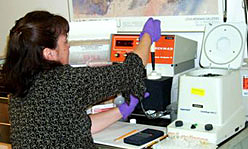
Glucose Analyzer
Glucose analyzers are used to analyze blood samples every 5 minutes in order to maintain specified blood glucose levels during glucose clamping with less than 5% variability.
Tracers to Measure Glucose Kinetics
Very small amounts of tracers are infused to give us information on the kinetics of selected parameters of metabolism. Tritiated radioactive, or deuterated non-radioactive tracers are infused to enable the calculation of glucose kinetics (e.g. endogenous glucose production), and glycerol metabolism.
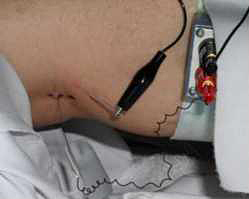
Sympathetic Microneurography
Sympathetic microneurography is a direct recording of the brain's neural output directed to muscle or skin arterioles. In the picture to the far right, the muscle sympathetic nerve activity recording is being taken from the mixed fiber peroneal nerve at the level of the popliteal fossa. A 200 micron tungsen microelectrode with 4-5 microns exposed at the tip is placed in a muscle fascicle to make an extracellular measurement of sympathetic C-fiber activity.
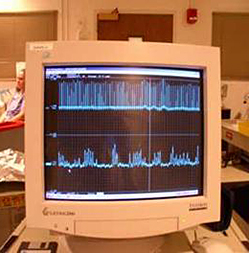
This is a measure of brain neural activity directed to control vasoconstriction of arterioles in the muscle bed. It represents activation of the sympathetic nervous system. The signal is amplified 100,000 times, filtered at a bandwidth of 700-2000 Hz, rectified, integrated at a 0.1 sec time constant, sampled at 1000Hz, with auditory feedback, and collected and displayed online, real time by computer.
To the left is the computer screen output of real-time muscle sympathetic nerve activity (MSNA, bottom graph) and the electrocardiogram (top graph) from a human experiment. Since MSNA bursts are linked to heart rate (R-R intervals), they must be collected and analyzed concurrently.
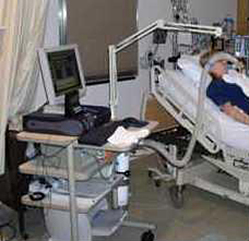 Metabolic Carts
Metabolic Carts
Indirect calorimetry is used to determine rates of oxygen consumption, carbon dioxide production, and respiratory rate for both exercise and resting metabolic rate. Fuel mixture utilized by the body is inferred from the respiratory exchange ratio (carbon dioxide production/oxygen consumption) during resting periods. Subjects breathe through a mouthpiece and one-way valve while expired respiratory gases are collected and analyzed using metabolic carts.
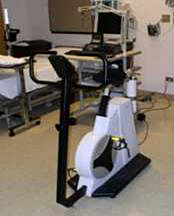 Cycling Ergometer (stationary bike)
Cycling Ergometer (stationary bike)
Electronically braked ergometers are used for subjects performing maximal oxygen consumption testing and moderate prolonged exercise during exercise induced stress related studies. The results are used for characterization and to predict workloads where exercise is used to provide an exercise stimulus for experimental protocols.
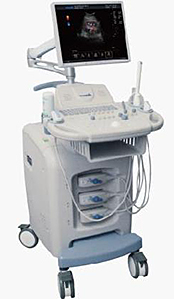 Flow Mediated Dilation (2D Doppler Ultrasound)
Flow Mediated Dilation (2D Doppler Ultrasound)
Flow Mediated Dilation (FMD) is a non-invasive way to determine the effects of the artery during an intervention. The artery can be measured using this ultrasound technique to see dilation or constriction in our studies during hypoglycemia, hyperglycemia or euglycemia. The brachial artery is used to map the artery, take baseline readings with blood flow and determine changes in flow during the above mentioned interventions. A control method during this technique involves giving nitroglycerin to see nitric oxide mediated dilation of the artery.
